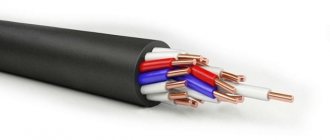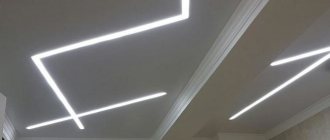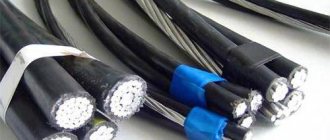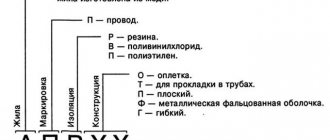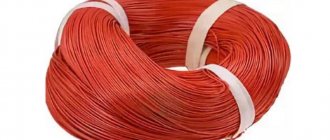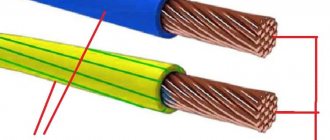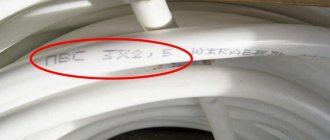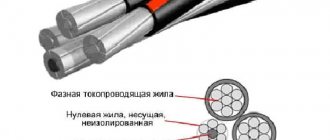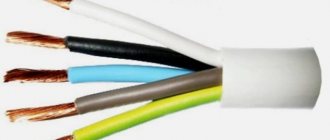KVVG cable is a multi-core copper or aluminum conductor used for remote control and automation control circuits. Due to the nature of its application, as well as limitations on the voltage and frequency of the current flowing through it, it occupies an intermediate position between high-voltage power cables and low-current communication lines. The decoding of the KVVG cable marking, what technical characteristics it has, where and for what purposes it is used will be discussed in this article.
Wire type KVVG
Explanation of the designation
The marking of a wire of this type consists of two blocks: alphabetic (consisting of 4-8 letters) and digital (two numbers separated by the multiplication sign “×”).
The designation (abbreviation) of the simplest wire KVVG 4×1 is deciphered as follows:
- “K” – the cable is a control cable;
- “B” - a material such as polyvinyl chloride plastic compound (PVC plastic compound) is used as insulation for the internal cores of the conductor;
- “B” – the outer insulation of the entire conductor (sheath) is made of PVC plastic;
- “G” – the cable does not have a special protective outer coating (can also be interpreted as “bare”).
The number block indicates the number of cores and the nominal cross-section of each of them. In this case, the wire contains 4 cores, each of which has a cross-section of 1.0 mm.
In addition to the basic symbols indicated above, the marking may also contain the following additional letters:
- “E” - the cable has a screen (a layer of aluminum foil and copper mesh located between the external insulation and the internal current-carrying conductors), which provides protection against the occurrence of induced voltage (noise) in it from nearby high-voltage power lines;
- “NG” - the material used for internal and external insulation has reduced flammability;
- “NG-LS” - the internal and external insulation of the wire, when melted, releases a small amount of harmful gases and smoke;
- “(A)” – the insulating material does not propagate fire;
- “C” - the internal current-carrying conductors of the control wire are color-coded.
On a note. If in the marking of this control wire there is a letter “A” before the mandatory letter block “КВВГ”, this means that the internal current-carrying conductors are made of aluminum. If there is no such letter in the marking, then the conductive elements of the cable are made of copper.
Marking of cable products
Those designations that are incomprehensible at first glance, which have already been mentioned above, have a clear basis, since they determine the technical characteristics of individual products and the scope of their possible application. The decoding of the abbreviations KVVGng, KVVGEng is as follows:
- K - indicates that this is a control cable,
- B (first) - means that the conductors have polyvinyl chloride (PVC) insulation,
- B (second) – a PVC shell is used,
- G – lack of protective cover,
- E – the presence of a shielded ball made of aluminum foil,
- NG – outer shell made of plastic compound that does not support combustion.
It should also be taken into account that since the designation does not have the letter A (aluminum) at the beginning, the conductors are copper.
Design and differences from power wires
KRPT cable
Structurally, the KVVG wire consists of the following parts:
- Core - the central part of the cable, consisting of one or more single-wire insulated conductors.
- Layers are several rows of conductive insulated conductors located radially around the core. Among the cores of one layer, there must be a counting pair - two conductors with red and blue insulation. The counting pair serves as a guide when connecting the remaining wires to various devices and sensors.
- Belt insulation - thin polyethylene or polyamide film, special paper (cable or telephone) located between the layers and the outer shell.
- Outer sheath - external insulation that does not have color markings and protects the cable and the current-carrying internal part of the control line from environmental influences.
In shielded KVVGE cables, between the outer sheath and the belt insulation there is a radial layer of aluminum or copper foil.
Structure of the KVVG control cable
The main differences between the KVVG cable and its power analogues include the following:
- Maximum voltage – conductors of the KVVG brand, unlike power analogues VVG, when passing alternating current through them, are capable of operating normally at a voltage of no more than 660 V (0.66 kV).
- Low resistance to breakdown voltage - the control wire of this brand must withstand a voltage of 2.5 kV for 5 minutes, while the power wire can withstand a current of 3 kV for 10 minutes.
- Color marking of conductors - in each layer there are 3 types of conductive conductors: a counting pair consisting of 2 conductors (blue and red); the remaining conductors having a color marking different from that which the conductors of the counting pair already have.
- Twisting of cores into layers - in control wires of this type, unlike power analogues, the internal cores are twisted around the core into radial layers, which are called layers (twists).
- Maximum heating temperature - the internal single-wire conductors of the KVVG cable can withstand heating up to a temperature of 700C, while power analogues can heat up to 75-800C;
- Insulation thickness – for a control cable of this type, the thickness of the external and internal insulation is on average 20-30% less than for power cables.
- Elasticity - the minimum bending radius of the control conductor ranges from 3 to 6 of its outer diameters, while for power conductors it is only 10-12.
Such a large list of differences is complemented by one more - the low cost of KVVG brand cables compared to power cables.
Design
Structurally, the cable consists of the following elements:
- One or more copper conductors.
- Insulating coating (PVC).
- General cable sheath (PVC).
Insulated conductors are marked with a color or a digital designation, which is necessary to identify the wires during installation.
The digital designation is used less frequently; more often the core insulation is colored as follows:
- one - red, is a guide;
- the second – blue;
- the rest are white.
If a numerical designation is applied, in order to facilitate identification, the core numbers are painted in a different color from the outer sheath.
Specifications
SIP cable 2: technical characteristics
KVVG cables have the following technical characteristics:
- Number of cores – from 4 to 37-61;
- The nominal cross-section of one core is from 0.75 to 4-6 mm2;
- Outer diameter – from 7.7 to 29.3 mm;
- Weight – from 78 to 1876 kg/km;
- Operating temperature range – from -50 to +500С;
- Relative air humidity at a temperature of 35 0C – 98%;
- Limit voltage and frequency of alternating current – 660 V and 100 Hz;
- Test voltage – 2,500 V;
- Maximum DC voltage – 1000 V;
- Electrical insulation resistance of the cores is from 6 to 10 mOhm/km;
- The thickness of the insulating layer of the cores is 0.6-0.9 mm;
- Maximum heating temperature – 700C;
- The minimum bending radius is from 6 to 3 outer diameters;
- Construction length – 150 m;
- Warranty period – 36 months.
Also, another important characteristic of such wires is the minimum laying temperature without preheating. For KVVG brand wire it is -15 0C.
Dimensions of the main types of KVVG wires
Important! The characteristics of control cables are determined by such regulatory documents as GOST 1508-78 and 26411-85.
Characteristics and application of the cable
When creating these systems, cables of the KVVG brand carry out a direct (fixed) electrical connection of the terminals of the sensors - sensitive elements with the terminals of the modules for receiving and converting electrical pulses taken from the sensors and perform the opposite task - they connect the terminals of the output modules of these systems with the executive controls of these systems.
Control cables can be used in AC and DC systems under all conditions. There are also several varieties of KVVG, information on them can be studied here - https://www.a-kabel.ru/kabel/kontrolnyiy/kvvg
- Technical characteristics of cable brand KVVG:
- The rated voltage of direct current is up to 1000 volts, and alternating current at a current frequency of up to 100 hertz is 660 volts.
- Test voltage for a duration of 10 minutes is 25 kV.
- Operating temperature +50 to -50°C.
- The permissible long-term temperature for heating its cores is up to 70°C.
- The permissible bending radius when laying it is 3 or 4 times its outer diameter, depending on the diameter.
- The permissible tensile force during installation should be no more than 4 kgf/mm².
- Can be used in rooms and places at a temperature of +35°C with a relative humidity not higher than 98%.
- The thickness of the insulation depends on the cross-section of the cores and ranges from 0.9 to 0.6 mm.
- At t°C = 20 degrees, with different sections of its conductors, the electrical resistance is 6-10 MΩ/km.
- Each current-carrying core has reliable fire-resistant polyvinyl chloride insulation.
- All cores are twisted along their entire length and are color or digitally marked. The color of the digital marking of the cores, which greatly simplifies the installation when switching the cores.
- The required length is discussed between the customer and his supplier when ordering.
- Storage of the KVVG cable in the open area of enterprises is possible for no more than two years.
- It can be laid along cable structures obliquely, vertically and horizontally along various cable structures and overpasses.
- You can lay cable routes for control cables in enterprise premises in:
- in special protective boxes, on shelves, trays
- in ceramic, asbestos-cement, welded, water supply and plastic low-pressure pipes
- cable ducts, blocks, collectors and tunnels.
Manufacturers
The main manufacturers of these cable products include such enterprises as:
- LLC "TD RT-Cable";
- JSC "Belaruskabel";
- LLC "TD Voronezhtelekabel";
- JSC "Cable"
- Rybinskkabel LLC;
- JSC Sibkabel;
- LLC "HKA";
- LLC "GK "Sevkabel"
Among foreign manufacturers of such an analogue of KVVG wire as NYM-O, the following are the most popular:
- "Nexans";
- "Denizli Cable";
- "TKD Kabel".
Classification and price
This type of product is produced, in addition to the usual version, with the following features:
- in a cold-resistant version, if the marking contains a hyphen of the designation HL;
- tropical version, with the letter T. This variety is resistant to mold;
- with a shielding layer - additionally designated by the letter E to eliminate the impact of adjacent wires during group installation;
- with non-flammable properties - letters NG.
Also, the specified material differs in the number of cores - up to 37 and their cross-sectional area - ranging from 7.7 to 29.3 mm.
The price varies, depending on the policy of the trading company and the type of product - ranging from 15 to 300 rubles per linear meter. The cost is also affected by the size of the purchased batch.
Installation
This type of control wire is laid in two ways:
- Closed - in reinforced concrete and concrete trays, tunnels, corrugated polyethylene pipes. The laying depth ranges from 0.5 to 0.7 meters;
- Open - in closed metal, plastic trays, boxes.
Reinforced concrete trays for laying control lines
The use of a closed installation method is more preferable, since it allows you to protect the control lines from the influence of the external environment.
Important! To avoid damage when laying in an open way, it is recommended to avoid sagging and strong tension in the line.
Despite the apparent ease of installation and relative safety of control lines, their installation should be carried out by qualified technical personnel with relevant experience and knowledge in this type of work. Independent installation and connection of such wires can lead to negative consequences.
Scope of application
This cable is intended for connecting control systems, control circuits, relay protection and other types of automated control and monitoring of various equipment. In this case, it is necessary to ensure that the connection does not move.
Laying can be done in any way - closed, open, including in an aggressive environment (for example, in soil with high acidity or salinity), by drawing in the open air, if sagging is not allowed. KVVG is afraid of stretching, as well as mechanical damage, therefore, in the case of open installation, it must be reliably protected from any kind of force.
Using KVVG
From the very name “control cable” or “control cable” it is not difficult to guess that this type of wire was originally intended for use in electrical circuits for monitoring or control.
In addition, as can be seen from the wide range of wires, there are many “not low-current” ones, thanks to which KVVG can be used to control contactors with high load and power, as well as to collect readings from limit switch sensors.
Also, the capabilities of the wire allow it to cope with the load of electric motors and other executive action motors. However, we recommend connecting them via power wires.
CS-CS.Net: Laboratory of the Electroshaman
Multicore signal and control cables: KVVG, MKSh, MKESH
This post is made up of two posts: sometime in 2012 (10/21/2012) I wrote a post about KVVG cables, and then, in 2016, a separate post about MKESH cables. In those days, I used these cables to the extent that there was little information. Now I have merged these posts into one, merged the comments from two posts together and added new photos and detailed information! And I will continue these posts with two more posts - about flexible power cables and about cables for RS-485. The date of the post has been changed to 2022 so that everyone can see this post and re-read it. Inserted are links to posts about connecting light control buttons and examples of using cables. Old photos from 2012 and 2016 are left throughout the story =)
The history of these posts goes back to my distant childhood: I was very fond of flexible round cables, which I lived with a lot and was constantly looking for them. I didn’t like telephone cables, since the wires were thin and inconvenient, but I liked cables with flexible cores.
It's all lyrics! But where do we need cables with a large number of cores in the switchboards or electrics of apartments/cottages? And in order to transmit a lot of signals to the shields! In general, I came to the search for cables with a large number of cores when I needed to connect buttons for pulse relays and wanted to make a cable in which one core was common (phase to the buttons), and the rest of the wires were signals from these buttons (about this first read the post about connecting impulse relays, and then the post about buttons for them).
Conventional cables for electrical wiring are available in 2, 3, 4, and 5 cores. Stock items are usually for 3 and 5 cores. But what to do when you need 7 or more veins? This is when multi-core cables come to the rescue, in which you can find 3, 5, 7, 10, 14 cores (this is most often the standard number of cores). I wanted to divide them into two groups: power and control, because cables of different brands and types have a different range of core cross-sections. For example, damn you will find a MKSh with 2.5 square conductors (or it will be wildly custom-made). On the other hand, you can find a KGVV cable with 2.5 or 4 square conductors!
Let's go find out!
Types and terminology of cable cores. Once again, the last time, so that no one gets confused.
And first we will deal with its mother’s terminology. Honestly? Over the years, you have bothered me with it, so I will write for the last time about the difference between “single-core and multi-core”, and then I will kick you for not knowing this =)
A single-core cable or wire means that there is only one conductor inside it. One thing, one vein. And multi-core - when there were more than one wires (individual wires) inside. That is, THIS is it:
Beautiful cable cut 1x630
This is a single core cable. With a cross section of 1x630 squares (this is from the post about thick cables). And a cable with at least 2x1.5 - two cores - is a multi-core cable.
And what everyone calls “single-core” and “multi-core” is correctly called single-wire and stranded. It’s better to speak in jargon: hard core and soft core, and don’t try to show off terms if you don’t fully understand them =)
Multicore cables. Why are they needed and why did I start using them?
Let me return to where this post began: why do we need cables with a large number of cores? Where can they be conveniently used? Let's think and write down different options, which will be united by the fact that one cable with a large number of cores will always take up less space than several cables with a smaller number of cores.
Multi-core signal and control cables: KVVG, MKSh, MKESH (rear view)
Firstly , as light control cables - buttons for pulse relays / PLCs. When we were installing a huge apartment (links to posts: One and Two and Three), in which there were 5 light control buttons in each room (and also in several places), then these buttons were very conveniently connected to the KVVG 7x1 cable, 5: one core was common, and the remaining six cores went to 5 buttons (one in reserve).
Here is the wiring diagram from that apartment:
An example diagram of using the KVVG cable to connect 5 buttons
Moreover, depending on how this line of buttons inside the panel is protected, the cable can be taken with sections of 1.5 squares (for a 10A circuit breaker, which immediately protects both the control circuits and light lines), or you can protect the control cable with a terminal with a fuse and take it to 0.5 square.
Secondly , such cables are convenient for connecting any equipment that requires a non-standard number of cores and cross-section. Well, at least the FAR taps, which have five wires (control + opening limit switch). There is enough cable 5x0.75 - but VVG power cables are produced at least 1.5 square meters. And if you don’t want to pull a thick cable, look for it among KVVG/MKSh.
Another example is fan coil units (from the post about the KNX shield on Prechistenka). This fan coil must receive power from the fan (L power, L Speed 1, L Speed 2, L Speed 3, N, PE) and control of the main refrigerant valve (L open, L close). Initially, the designers threw here as many as three cables of 5x2.5 cores (why, who knows), and I put it all in one KVVG 7x1.5.
Thirdly , I came up with a clever use for KVVG cables when I was coming up with a project for controlling light in a country house. There were rooms in which there were many groups of light, but all these groups were lightly loaded: the entire room hung on one 10A machine.
What could be done (I talked about this feature in detail in the post about buttons for impulse relays)? And make a main cable based on KVVG in such a way as to pack in the phases after the pulse relays, common zero and PE (we can do this ONLY if all these pulse relays hang on one machine), drag such a cable from the switchboard to the room, and then there through a maintenance-free junction box, route it into separate 3x1.5 cables to the lamps as if they came from the switchboard that way. This solution saves a lot in money and space in the routes that cables occupy.
VERY IMPORTANT!!! Such perversions, when several different signals are packed into one cable, should be used only when this cable is completely disconnected by one machine in the switchboard. This is dictated by safety rules: the entire cable must be disconnected entirely; it should not be the case that part of the cable cores are powered by one machine, and part by another (as was the case in this damn example).
Fourthly , such cables are shielded. Therefore, they are convenient for connecting different sensors (temperature or pressure - in a future post I will tell you about such a shield). In this case, it is convenient for us to take a flexible MKESH cable (with a screen) of small cross-section (0.5 or even 0.35 sq. mm) and gracefully pull it to the sensor.
KVVG cables (and their derivatives). Counting and designation of cable cores.
We start with KVVG cables. Now there are all their modifications, which are the same as those of power cables: KVVG, KVVGng, KVVG(A)ng-LS. These are cables that are called control cables because they can have a large number of cores (from 4 to 37 pieces). The cores are single-wire (rigid), cross-sections from 0.75 to 2.5 sq. mm. Most often, cables with cores of 1.5 square are available, but finding 0.75 is already more difficult (according to reviews from customers for whom I laid such cables in the project).
I classify this cable as a power cable because it has rigid cores and is designed for voltages up to 600 volts. That is, running 230V through it and using it in stationary wiring is a really nice thing! And here its single-wire conductors come into our hands: I dragged it onto the terminals in the switchboard - and you don’t have to worry about it. Well, or stuck it into the contacts of the light buttons - and you don’t worry either.
In industrial applications, this cable is popular at all kinds of substations: it is convenient to connect drives or measuring circuits with them. Somewhere I had a photo of a control panel with either a switch, or a disconnector (or something else) - and KVVGhi are clearly visible there. If necessary, such cables are also produced with shielding (designation “KVVG E ”).
The first thing I encountered when I bought KVVG for my first project was that it has a completely different logic for designating cores. In ordinary power cables (3 and 5 cores), the cores are always designated by color: either the entire core is painted, or a colored stripe is made on it. Everything is clear with this: this is required by the standard for power cables - there it is necessary to clearly define where the phases are (phase), where is zero and where is PE.
But all control or installation cables have a completely different designation system! I'll tell you about her now! Here is a photo of two KVVG cables. One has multi-colored wires (and that's what you might expect), and the other is supposedly a mistake, only two colored wires, and the rest are white and call them whatever you want.
Cables KVVG and KVVG-ng 7×1.5 sq.mm
Error? No! It's not a mistake! And not the machinations of factories or any successful managers. And not even machinations like “wow, there’s a shitload of white wire left, now we’ll run it all down to KVVG, don’t give a damn, they’ll ring somehow”... =) Moreover, all this generally depends on the plant and even on the batch of cable. Some factories always make colored wires, and some sometimes make colored + white, or colored + red, or whatever (special trash happens with colors at MKSh).
This is still not a mistake - but a special system of notation for cores! And any installer will disconnect this same KVVG with white wires and not even be surprised! Do you remember multi-pair cables of the “Twisted Pair” type? There, each pair had its own color, and groups of pairs also had their own color. And the color indicated the serial number of a pair or group of pairs. We had to remember five colors - and we could accurately determine the numbers of pairs and groups.
And in multi-core cables like KVVG, MKSh/MKESH (and looking ahead - cables like KGVV, RPSh) there is also a counting: the cores are counted in a circle ! Therefore, we only need to know the beginning and direction of the circle - and for this, two colored wires in the cable are enough!
Let's look at a simple example using those two cables from the photo above (from 2012). Look at the left cable in the cut:
Type of cut of cables KVVG and KVVG-ng
Do you see how the veins are arranged? There is an outer circle of six pieces and one vein in the center. So we take it and count in a circle in any direction we like. For example, like this:
- Red = first;
- First white after red = second;
- Second white = third;
- Third white = fourth;
- Fourth white = fifth;
- Blue = sixth.
Well, the central one is the seventh, it is in the center and is easy to find. You can count this way either clockwise or counterclockwise. And if there are more than seven cores in the cable, then there will be several such circles - they will be nested inside each other.
Check out the new photo. On the left is KVVGng 10x1.5. Two circles are visible here: eight on the outside and two in the center. We count the same way: green, yellow and go clockwise. And on the right is a cable from another factory (7x1.5), in which all the cores are immediately colored from the factory.
KVVG cables for 7 and 10 cores from different factories (count of cable cores)
Don't expect standard colors: it's just the core number that is important here, not PE or L/N, because the cable is supposed to be used as a control cable. Therefore, when you install it, you need to mark the wires in such a way that other installers can figure them out after you.
For marks, you can use tags, colored heat shrink or lines on the cores (if they are white, then with a black marker): the line is placed according to the core number (this method was used in the old days). Here is an example on the same cable with ten cores:
An example of marking cable cores with dashes
Well, very close to you you can find KVVG cables connecting traffic lights! =) Here I was in 2012 photographing the temporary connection of a traffic light on the Enthusiasts Highway:
Application of KVVG cable in traffic lights
People here are at WAGO - they spliced several KVVGs together, because at that moment the crossings were being rebuilt there and the traffic lights were temporarily moved.
Application of KVVG cable in traffic lights
Cables of the MKSh/MKESh type and their application.
Now we move on to the MKSh/MKESh cables (shielded). We list them as interconnect mounting ones, but it’s awesome to use them as cables for connecting all sorts of crap with low currents. MKSh/MKES will not have large sections (maximum about 0.75..1.5 sq.mm), but there are smaller sections than KVVG. For example, 0.35 and 0.5 sq. mm. The number of cores is up to 14 pieces. Operating voltage is up to 500 volts (that is, you can drive the mains 230V easily and without problems). The cores are flexible (multi-wire).
Their most important advantage is flexibility. From such a cable you can make some kind of control loop for home crafts or some equipment, connect sensors or some kind of servos: the cable can be taken with a small cross-section and it will have a small diameter, and the flexible cores can be tinned and soldered.
As soon as I began to move away from conventional pulse relays, which I protected with a 10A automatic machine and therefore used 1.5 sq. mm cables for the PLC and Logo, I began to use MKSh type cables for the light button lines, so that these cables took up less space in cable routes.
Since the cables have flexible cores, if we plug them into the spring contacts of buttons/switches, then these cores must be crimped with lugs NShVI (for UNICA) or NShV (without skirts) for those series of switches and buttons where NShVI because of its skirt they can't reach.
The use of MKSh cables for connecting light control buttons throughout the apartment (via pulse relays / PLC / Logo)
With flowers, MKSh is even more careless and trashy than KVVG. Check out these three cables. All have five wires, but the colors are completely different =))
Cables MKSh 5x0.5..0.75 and wires of different colors (this is normal)
But the rule for counting cable cores is the same. Here you can clearly see it in the cut. We take the sequence again, for example, clockwise - and it flashes: black, blue, then...; yellow, green, more...; white, yellow, more...
Counting of wires in cables MKSh/MKESH/KVVG and other similar ones
We were installing one shield, the cables for which had to be found urgently - they had to be assembled from different batches and different factories from stock. So one time (I’ve never seen anything like this) I came across a MKSh, in which the cores were laid in pairs and they had to be determined by these pairs:
An interesting MKSh/MKESh cable, in which the cores are twisted in pairs
MKSH cables are exactly the same as MKSH, but with a shield around the cable. That is, they can transmit sensitive signals. Or vice versa - make sure that the signals from this cable do not interfere with others. Well, of course, the screen is not a panacea for everything. Just now a guy wrote to me about how he can shield the KVVGE for controlling a servo valve from a pump with a voltage of 6 kV. Damn, no way. Carrying cables and fucked... =)
Here are samples of MKESH cables with different numbers of cores and batches (again, I remind you that the colors of the cores are always different, and some factories make multi-colored cores).
MKSH cables (shielded), similar to MKSh cables
In the boiler room panel in Papushevo, which I will talk about in future posts, I used MKESH for temperature and pressure sensors for the boiler room. These sensors had a screen or PE contact, and on the sensor side I connected the MKESh screen to these contacts.
And from the shield side I cut the MKESH in this way: I released the screens back and put heat shrink on this place. Then I connected these screens to PE terminals, which I placed in the shield specifically for this purpose.
Output of the shield of MKESh cables inside the shield when connected
In 2016, I was assembling a switchboard at ARIES, and there I had the task of passing measurements of network parameters through a place in the switchboard in which there are a lot of 0..10V control signals from the PLC. I thought about it and bought MECSH 10x0.75. Now I’ll insert a piece of that post.
Cable MKESH 10×0.75
I decided to get confused for fun. I am assembling, then, the same shield on ARIES that I already mentioned - how I used all sorts of installation tricks there - and in this shield I have a small block of terminals, to which signals from the network input and from the current transformers are output. So that the PLC can receive consumption data and do something with it. But my network input is located on top of the shield. And the PLC is at the bottom. And next to this network parameters input module (that’s the name of the thing that measures everything and sends it to the PLC via RS-485) there is a temperature input module.
Well, somehow I got bored of dragging a bunch of measuring tails across the entire shield along with all sorts of signal ones. And I began to think, like an audiophile - can I shield with something? Or some kind of tourniquet to invent? And then I began to look for some cable that could suit me: have 10 cores, a screen and be designed for mains voltage. I swept away all the low-current wires and cables - the operating voltage is not right there. I rejected KVVG because it was very thick with 10 cores and was also single-core, but I wanted to have beautiful flexible wiring. And I found it - MKESH. I took MKESH 10×0.75. Its diameter is about 11 mm, and according to all documents it is designed for 500 volts up to 400 Hz. That all my measuring supplies are covered with a huge margin!
Today I went to Elektromontazh, bought a 4-meter piece there and started having fun with it. I cut it off, cleaned it up, and looked at how it works. The screen there is made very well - with honest braiding, like in the Soviet coaxial type RK-75, and not with some kind of foil. The wires inside are hellishly insulated, and so is the outer sheath.
MKESH cable 10×0.75 (rear view)
The photo here is bad, but we again see two circles of veins. Each circle has two colored veins (here red and yellow), and again we count everything in a circle.
I cut it up cunningly. I unraveled the entire screen, twisted its wires, wrapped them in thin heat shrink, and then pressed the TML tip onto it. And after that, the entire tail of the cable was covered with another heat shrink. I ended up securing it near my terminal block for measurements:
MKESH cable 10×0.75 and automation panel (network input control)
And I lowered it into the lower part of the shield inside the WR profile: since this is a cable, and not separate wires, we can lay it in the metal as if it were running in a metal tray.
MKESH cable 10×0.75 and its installation behind the WR-Frame
Near the measuring module, I placed it at the very, very bottom of the punched box - it will not interfere with any small wires passing through it. And then I will connect it further when I print markings on the wires, because the cable itself will also need to be called and marked.
MKESH cable 10×0.75 and network parameters input module OWEN ME110-220.3M
Here's a small discovery. I liked the cable and made me happy! If I don’t find anything thinner in diameter, I’ll buy it 2x0.5 and use it to distribute analog signals 0..10V.
...and the impudent goat began to eat the cable sample. Very much her part of the copper screen was penetrated.
MKESH cable and impudent shepherd
I got drunk and fell asleep, you bastard. And then she’ll probably puke again =) She’s sick of it! =)
MKESH cable and impudent shepherd
Addition from 2022 about the cat. This CREATURE gnawed all the whiskers of the second cat, pissed and vomited everything it could, then ate the slippers, and then ate a piece of the duvet cover!!! And he came to her so normally - no vomit anywhere, complete peace and quiet.
The cat ate part of the duvet cover!
After that, they dubbed her super-ophthalmus and gave her back to the same place they took her from - let other fools mess with her. Never have fucking cats! If you want, in another N or M years I’ll post a clip about this motherfucking ophthalmus on YouTube!
That's all! In the next posts (I will publish them in a couple of days) I will tell you about multi-core power cables and cables for RS-485.
